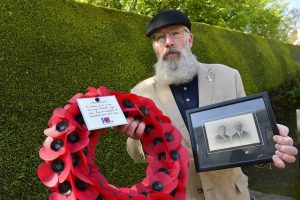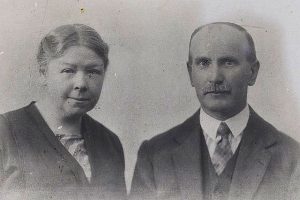Many of you will possibly have seen this article because you purchase the Belfast Newsletter, the paper which published it, but there are many who would not see this report other than by our highlighting of it.
The article highlights a long-buried truth regarding the attitude of the ‘Irish Republic’ toward Protestants and is an attitude which has been encapsulated in the mindset of Sinn Fein/IRA as its murder campaigns have shown.
It contains historic facts long forgotten and deliberately buried by the defenders of Popery.
Sincerely in Christ’s name,
Ivan Foster
By Philip Bradfield
Belfast Newsletter, Thursday, 5th May 2022, 6:08 pm.
Neale Jagoe’s great grandfather William and great grandmother Elizabeth Jagoe were among those who fled the area after the atrocity, which took place 100 years ago last week.
“The key fact was that these civilians were killed nine months into an IRA truce and four months after the treaty was signed with the British by Michael Collins,” Neale said.
The IRA launched the killing spree after IRA Acting Commandant Michael O’Neill was shot – apparently in self defence – while leading an armed raid on a Protestant home. The subsequent IRA murder spree saw 13 boys and men – two aged 16 and the rest up to to 82 – shot across the Bandon Valley over three days between 26 and 28 April 1922.
 Neale Jagoe pictured with a photo of his great grandparents William and Elizabeth Jagoe from Co Cork and the wreath he laid in memory of the 13 boys and men murdered in the Bandon Valley Massacre they escaped. (Picture By: Arthur Allison/Pacemaker Press._
Neale Jagoe pictured with a photo of his great grandparents William and Elizabeth Jagoe from Co Cork and the wreath he laid in memory of the 13 boys and men murdered in the Bandon Valley Massacre they escaped. (Picture By: Arthur Allison/Pacemaker Press._
“Another 19 Protestants in the Bandon Valley who were also intended targets escaped before they could be killed,” he said. Some 100 Protestant families then fled west Cork as they no longer felt safe.
Mr Jagoe, who studied in Trinity College and spent 20 years as a UK diplomat, now lives in Ballycastle. His uncle Bobby Crilly, an off duty RUC officer was also murdered by the IRA in Fermanagh in 1981.
“My great grandfather had been tipped off by an informant within the IRA who knew him through business. So the IRA called at the door in Dunmanway and my great grandmother shouted that her husband wasn’t in,” he said.
“The IRA then shot out the windows and shouted ‘We’ll get Jagoe’ yet. The family then escaped over the fields.”

William and Elizabeth Jagoe fled a murder attempt by the IRA in Co Cork during the Bandon Valley Massacre and later found refuge in Belfast.
(Picture By: Arthur Allison/Pacemaker Press.)
The couple fled to Hampshire and later found “safe haven in Belfast” with their son, as “political refugees”.
Neale notes that, based on official government records, historian Robin Bury found that some 40,000 Protestants fled from the south due to sectarian intimidation and murder from 1920-23. Many of them sought safety in Ulster
“Belfast became a place of refuge to these people. That point was never really made during the year of the centenary for Northern Ireland. These people were political refugees.
“It is frustrating that any time this massacre is brought up academics speculate on the motives of the IRA, which takes the focus away from the fact that these were sectarian murders.
“The reputation of these people has been tarnished with the informer slur which seems to distract from the central issue, that these were sectarian murders.”
“It is also debated as to whether it was a renegade IRA unit and whether it was unsanctioned. But the fact is that my great grandfather was tipped off by an IRA officer.”
“So if it was not the IRA that was behind the attack, how was an IRA officer able to tip him off that they were coming to kill him?
Despite it being 100 years ago, he feels there is unfinished business on the massacre.
Last week he laid a wreath at a special commemoration service in Cork held by the Church of Ireland.
“It is important to me because these were my relatives who were forced from their homes. So I think it is important to commemorate the 13 men and boys who were murdered – along with the hundreds who had to flee.
“I also think there is a great deal of ignorance. Many people just don’t know that this event took place. I think it throws up some uncomfortable truths and I think Irish society north and south needs to be aware of these events and there needs to be come recognition that wrongs were committed against the small vulnerable Protestant minority in west Cork at the time.
“There needs to be some recognition of this and perhaps difficult conversations need to take place. There needs to be some recognition from the Irish state of the wrongs that were done.
“To my knowledge, while the murders were widely condemned there were never properly investigated nor was anyone ever brought to justice.”
He emphasises that his great grandparents “never held any bitterness” despite having to flee their home for their lives.
The Taoiseach’s office was invited to respond.
The Church of Ireland Bishop of Cork, Cloyne and Ross, Dr Paul Colton marked the centenary last week by making pastoral visits to the parishes most affected.
Bishop Colton said that the historiography of the period and the massacre events “has been written about extensively and debated with different narratives, emotions and responses elicited”.
He added: “Why it happened and what the motives of people were are elusive questions. What can we know with certainty at this remove?”
The Bishop emphasised, however, that at another level the facts were straightforward. He named all 14 of those who died in the events, including the IRA Commandant, Michael O’Neill – whose shooting during a raid on a Protestant home appeared to spark the string of IRA reprisals – and at whose grave he laid a wreath.
The Protestant victims were Thomas Hornibrook, Samuel Hornibrook, Herbert Woods, James Buttimer, David Gray, Francis Fitzmaurice, Robert Howe, John Chinnery, Robert Nagle, Alexander Gerald McKinley, John Buttimer, James Greenfield and John Bradfield.
“Two of those [murdered] were 16 years of age and the oldest was 82,” he added. “Twelve were members of the Church of Ireland in this Diocese. Attempts were made on others’ lives and they had to escape, many never to return. We know that in the years that followed many people from Cork, Cloyne and Ross felt insecure in this part of the world and left.”
Announcing his approach to the centenaries Bishop Colton said he was “not in a position to adjudicate on the historiography of that period” but that as lead pastor in the diocese, his primary duty was “to ensure that in prayer and liturgy, these people and events are appropriately remembered in the context of this Decade of Centenaries”.
A remembrance service at St Mary’s Church of Ireland, in west Cork last week was led by Rev Cliff Jeffers.
Another article worth reading:
